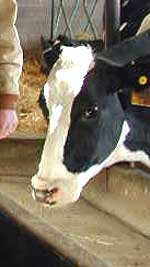By Jeff Horwich
Minnesota Public Radio
October 1, 2002
Work is almost complete on what may be the largest study ever attempted of animal feedlots. Minnesota farmers, government officials, and environmental groups all had a role in designing the report, which has taken four years and cost $3 million. The "Generic Environmental Impact Report on Animal Agriculture" runs more than 6,000 pages and purports to address all the important effects of animal manure on the state.
| |
|
|
|
||
During the 1990s, a new reality of Minnesota agriculture began to sink in. The number of dairy farms was shrinking, but the number of cows per farm was on the rise. For pigs, the effect was more dramatic. In just a 15-year period, the average number of hogs per farm jumped 250 percent.
And those animals were making messes the likes of which the state had never seen. At one point in 1998, farmers worried the state would cap the size of their herds. George Johnson, a scientist with Minnesota Planning, says lawmakers discovered an information gap.
"The Legislature was wrestling with all kinds of problems about large feedlots," Johnson said. "A lot of this revolved around permitting decisions, and people being concerned about health problems and air pollution and water pollution. And the Legislature ... as they investigated it, many times they found that a lot of this basic information (wasn't) available or (wasn't) in a convenient form. "
Lawmakers commissioned what Johnson now calls "an encyclopedia of animal agriculture." Johnson, under the auspices of Minnesota Planning's Environmental Quality Board, was asked to serve as a neutral coordinator for the project.
| |
|
|
|
||
He assembled two-dozen players with different interests in the feedlot debate -- environmental groups, farmers, beef, pork and poultry interests, along with representatives from local government and various state agencies.
The final product of this Citizens Advisory Committee looks at the effect of livestock farming on the state economy, the environment, human health, animal health and local communities.
There are 76 main recommendations. They include a call for the "judicious use of antibiotics" in animal feed, faster response to odor and other complaints, and an assertion that small and large feedlots are equally bound to play by the rules. The report also calls for more state money for research and enforcement.
One major feedlot interest conspicuously missing from the project is ValAdCo. The hog feedlot cooperative in Renville County has been battling residents' odor complaints for years. Johnson says the ValAdCo situation helped spur the project on, but ValAdCo did not participate directly in the committee.
State funding for the project is just about to expire. It is up to the Legislature to appropriate additional money to keep the report updated in future years.
| |
|
|
|
||
Members of the advisory committee see different things to like in the final report.
"One of the key findings from the water quality portion of the report was that we have a lot of overapplication of phosphorous going on in Minnesota," says Kris Sigford, water quality director for the Minnesota Center for Environmental Advocacy. "This is designed to get at that and try to address that."
The report calls for a statewide "phosphorous index," which Sigford says farmers can use to determine when they're putting down too much manure on their fields.
Committee member Gary Allen sees the giant report as more of a tool for government officials than for the individual farmer. Allen owns a 500-cow dairy near the southeastern Minnesota town of Eyota.
He says doing the study got farmers and environmentalists talking again, and he hopes having this new standard base of information might clear up bureaucratic confusion for livestock farmers.
"Some of these areas really scare the average person who says, 'I don't want to tangle with the MPCA' or 'I don't want to tangle with the environmental community.' And it probably limits some people wanting to go in and reinvest," Allen said.
At the same time, Allen's not sure a 6,000-page report will really make things less complicated. In Stearns County, which has the most feedlots in the state, officials agree the report is a lot to absorb. Those pages may well reveal the future of livestock farming in the state, but they say they've got to read them first.
As one soil and water official joked, the feedlot encyclopedia is likely to be his bedtime reading for quite a while.
More from MPRMore Information



